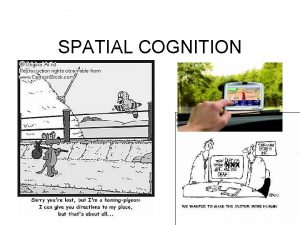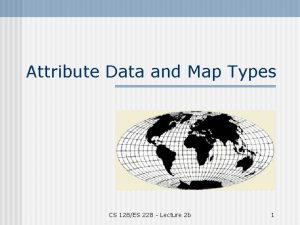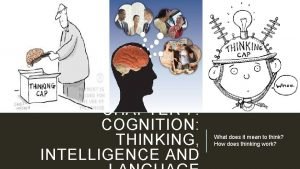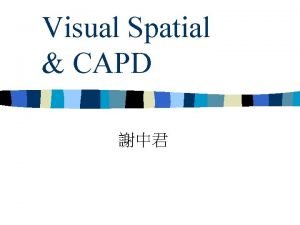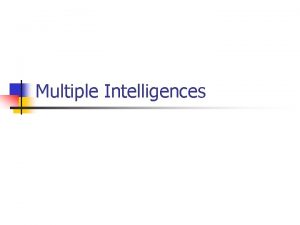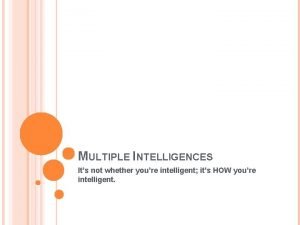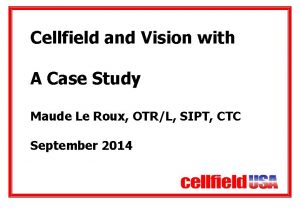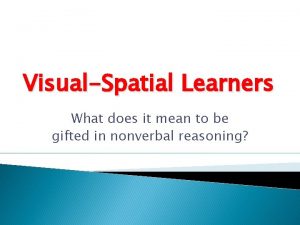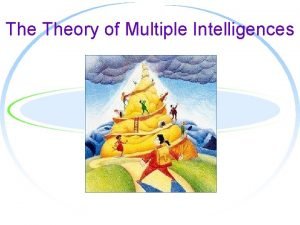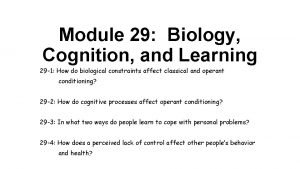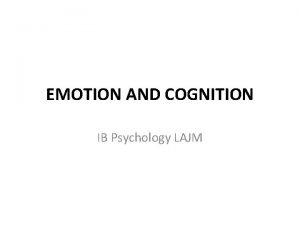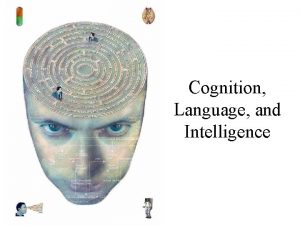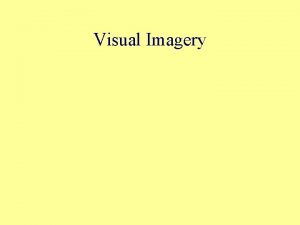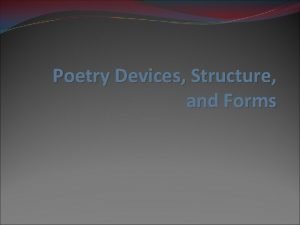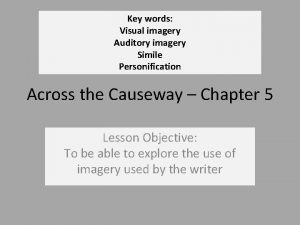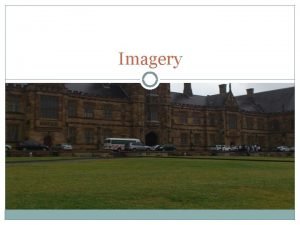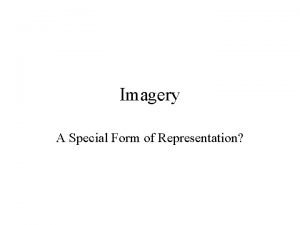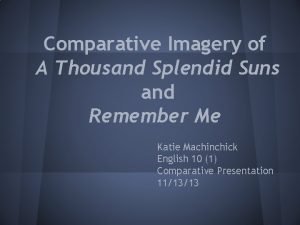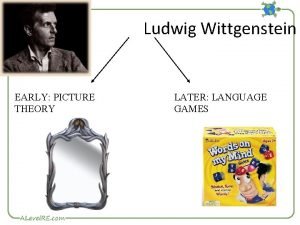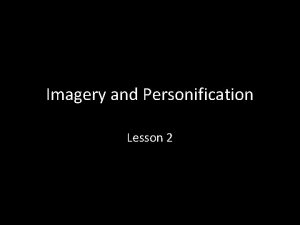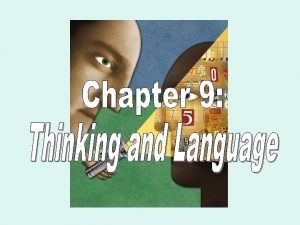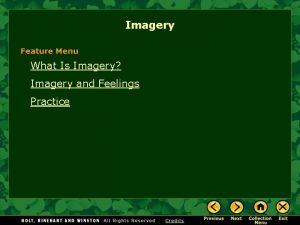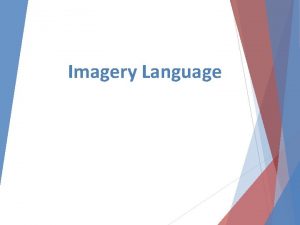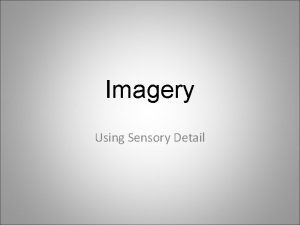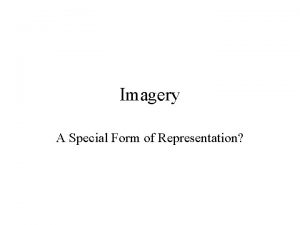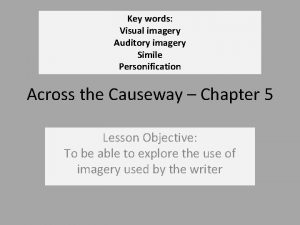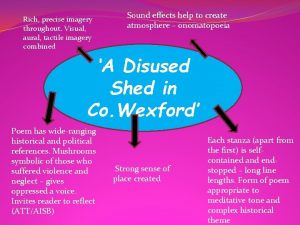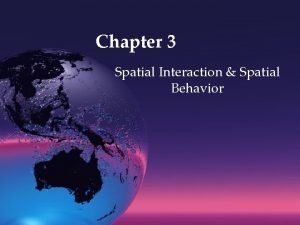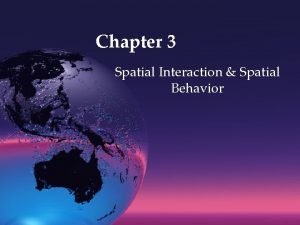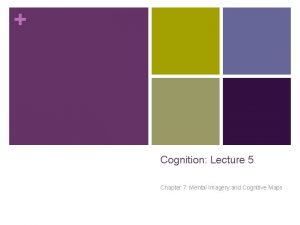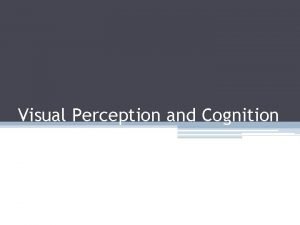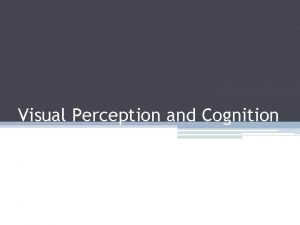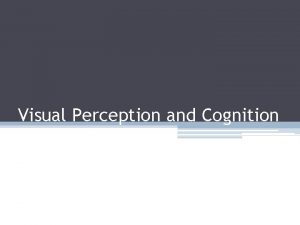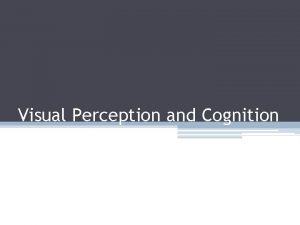CHAPTER 8 VISUAL IMAGERY AND SPATIAL COGNITION Jennifer


























- Slides: 26

CHAPTER 8: VISUAL IMAGERY AND SPATIAL COGNITION Jennifer Hightower, Jordan Scales, and Kandace Howard

MNEMONICS AND MEMORY CODES

The Dual-Coding Hypothesis ■ Long-term memory has two distinct methods of coding. – The verbal method contains information about linguistic meanings. – The imagery method involves mental images representing what an item looks like. ■ Pavio’s study provided supporting evidence for this hypothesis. – When possible, participants within the study formed images on noun pairs.

The Relational-Organizational Hypothesis ■ The hypothesis that imagery improves memory because of increased associations between imagery and items to be recalled. ■ Bower’s experiment was specifically designed to distinguish between the Relational-Organizational Hypothesis and the Dual-Coding Hypothesis. – Those in the rote memorization group recalled 30% of the paired associates – In the noninteractive imagery group, participants recalled 27% of paired associates – Participants who formed interacting images recalled 53% of paired associates

EMPIRICAL INVESTIGATIONS OF IMAGERY

Mental Rotation of Images ■ Many studies show that people create and manipulate images to answer questions. ■ A study by Shepard and Metzler showed that the time it took participants to determine if the two images were of the same object was proportional to the angle of rotation of the drawings. ■ A later study done by Lynn Cooper focused on whether people are mentally rotating the whole object or just parts of an object. – The study found that reaction times were not affected by the complexity of the objects that participants were being asked to rotate, showing that objects are mentally rotated as a whole.

Scanning Images ■ Imaginal scanning is an idea that the amount of time it takes a person to mentally scan an image represents properties about the image, such as distance and time. ■ A study by Kosslyn, Ball, and Reiser tested theory of imaginal scanning. – The results suggested that the imaginary distance between parts is related to the amount of time it takes a person to scan it.

THE NATURE OF MENTAL IMAGERY

Finke’s 5 Principles of Visual Imagery ■ Robert Finke (1989) ■ Describe fundamental nature and properties of visual images ■ Each covers different aspect or characteristic of imagery 1. Implicit Encoding 2. Perceptual Equivalence 3. Spatial Equivalence 4. Transformational Equivalence 5. Structural Equivalence

1. Implicit Encoding “Mental imagery is instrumental in retrieving information about the physical properties of objects, or about physical relationships among objects, that was not explicitly encoded at any previous time” ■ Can obtain information that was not intentionally stored from images ■ Use imagery to answer questions for which you don’t have a directly stored answer ■ Ex: determining the number of cabinets in your kitchen

2. Perceptual Equivalence “Imagery is functionally equivalent to perception to the extent that similar mechanisms in the visual system are activated when objects or events are imagined as when he same objects or events are actually perceived. ” ■ Use many same processes for mental visualization as visual perception ■ Perky (1910): Unable to distinguish between imagined image and faint picture ■ Farah (1985): Imagery can prime the visual pathway to detect actual stimulus

3. Spatial Equivalence “The spatial arrangement of the elements of a mental image corresponds to the way objects or their parts are arranged on actual physical surfaces or in an actual physical space. ” ■ Visual imagery has spatial properties that are similar to visual representations ■ Evidence from scanning studies: time correlated to distance ■ Kerr (1983): same results for blind participants

4. Transformational Equivalence “Imagined transformations and physical transformations exhibit corresponding dynamic characteristics and are governed by the same laws of motion. ” ■ Transformations of mental imagery have the same characteristics as physical transformations ■ Evidence from mental rotation studies: continuous, intermediate orientations, time, whole object

5. Structural Equivalence “The structure of mental images corresponds to that of actual perceived objects, in the sense that the structure is coherent, well organized, and can be reorganized and reinterpreted. ” ■ Visual images are formed in pieces that fit together to form a final image, as is the case with physical pictures ■ Kosslyn, Reiser, Farah, &Fliegel (1983): more details longer time to draw more conceived complexity longer time to draw

Critiques of Mental Imagery Research and Theory 1. Tacit Knowledge and Demand Characteristics 2. The Picture Metaphor 3. Propositional Theory

Tacit Knowledge and Demand Characteristics ■ – – Pylyshyn (1981) Rely on underlying beliefs about task rather than use of mental imagery Expect experiment to work in certain way Ex: Mentally pausing in scanning tasks Demand characteristics: demand to behave in certain way Finke (1989): tacit knowledge and expectation can distort results Pausing when moving objects Intons-Peterson (1983): experimenter expectancy effects Experimenters give cues to participants Primed undergraduate students

The Picture Metaphor ■ Differences exist between pictures and images 1. Can look at picture without knowing what it’s a picture of but cannot construct an image without knowing what it is 2. Meaningful parts of images disappear when fading, but pictures can be disrupted arbitrarily 3. Images distorted by viewer’s interpretations (Ex: labels, reproducing common objects)

Propositional Theory ■ Single code that is neither visual nor verbal ■ Based on relationships between concepts ■ – Pylyshyn (1973): all results can be explained by prepositional theory Not using imagery but propositional representations Kosslyn (1976): association strength High association and low visual vs. Low association and high visual

NEUROPSYCHOLOGI CAL FINDINGS

Neuropsychological Findings ■ Cerebral blood flow shows activity in the areas of the brain important for visual processing when working with mental imagery – Replicated with event related potentials measuring electrical activity in the brain ■ Creating visual images activates the Occipital Lobe ■ When forming images of faces, the fusiform face area is activated ■ When forming images of places, the parohippocampal place area is activated ■ Farah (1985): not susceptible to demand characteristics ■ Kosslyn (1995): against propositional theory, visual areas active

SPATIAL COGNITION

Spatial Cognition ■ How people represent and navigate through space. ■ 2 parts: Locomotion & planning destination/path ■ Spatial Updating: Revising mental images ■ – – – Tversky’s 3 Types of Space: 1. Space of Body 2. Space Around Body 3. Space of Navigation

Space of Body ■ Location of body parts ■ Direction/Movement ■ Ex. Ducking to avoid something

Space Around Body ■ Immediate surroundings ■ – – – 3 axes for object location Up-Down/Head-Feet Left-Right Back-Front ■ Fastest: Up-down ■ Slowest: Left-right

Space of Navigation ■ Large spaces ■ Not all perceived at once (ex. giving directions) ■ Cognitive collage vs. cognitive map ■ Tend to follow NESW

QUESTIONS?
 Xxxفضایی
Xxxفضایی Spatial data vs non spatial data
Spatial data vs non spatial data Chapter 7 cognition thinking intelligence and language
Chapter 7 cognition thinking intelligence and language Chapter 7 quiz cognition thinking intelligence and language
Chapter 7 quiz cognition thinking intelligence and language Visual spatial relations
Visual spatial relations Who
Who Interpersonal intelligence celebrities
Interpersonal intelligence celebrities Visual spatial relations
Visual spatial relations Upside-down brilliance: the visual-spatial learner
Upside-down brilliance: the visual-spatial learner Visual or spatial intelligence
Visual or spatial intelligence Interpersonal celebrities
Interpersonal celebrities Interpersonalintelligence
Interpersonalintelligence Module 29 biology cognition and learning
Module 29 biology cognition and learning Emotion and cognition ib psychology
Emotion and cognition ib psychology No word
No word Cognition and personalization
Cognition and personalization Whats visual imagery
Whats visual imagery Smell imagery
Smell imagery Type of imagery
Type of imagery Visual imagery example sentence
Visual imagery example sentence Imagery meaning in poetry
Imagery meaning in poetry Example of visual imagery
Example of visual imagery Imagery in a thousand splendid suns
Imagery in a thousand splendid suns A picture
A picture What is visual imagery
What is visual imagery Imagery vs personification
Imagery vs personification Cognition refers to
Cognition refers to
